An investigation into students’ engagement in English speaking activities at political academy
Students’ engagement in English speaking activities plays a crucial role in developing students’
English language proficiency in general and speaking skills in particular. On the bases of a
thorough investigation into the situation of teaching and learning English at Political Academy,
the researcher focuses on investigating the level of students’ engagement in English speaking
activities, and determining the factors affecting students’ engagement in English speaking
activities at Political Academy.
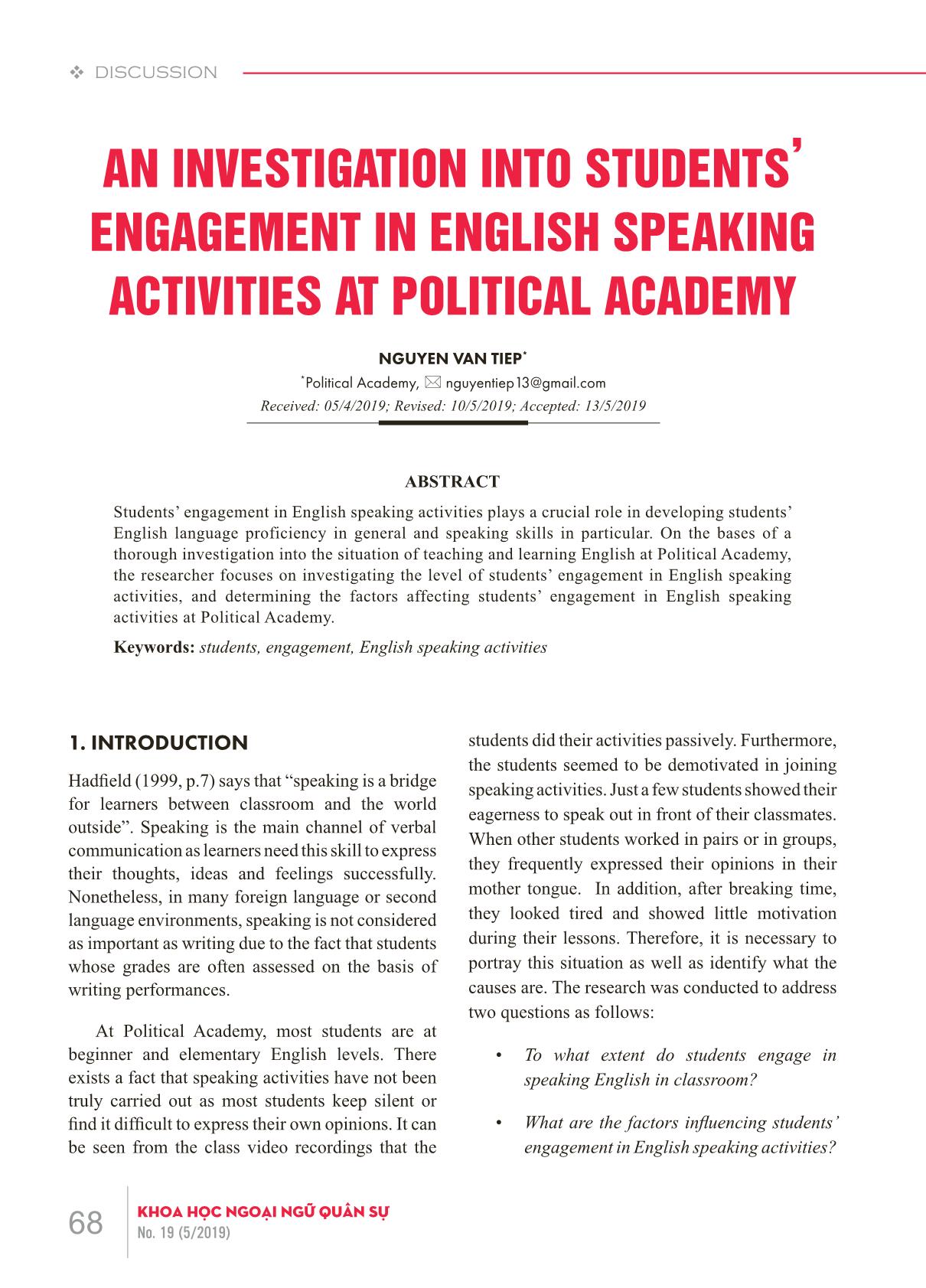
Trang 1
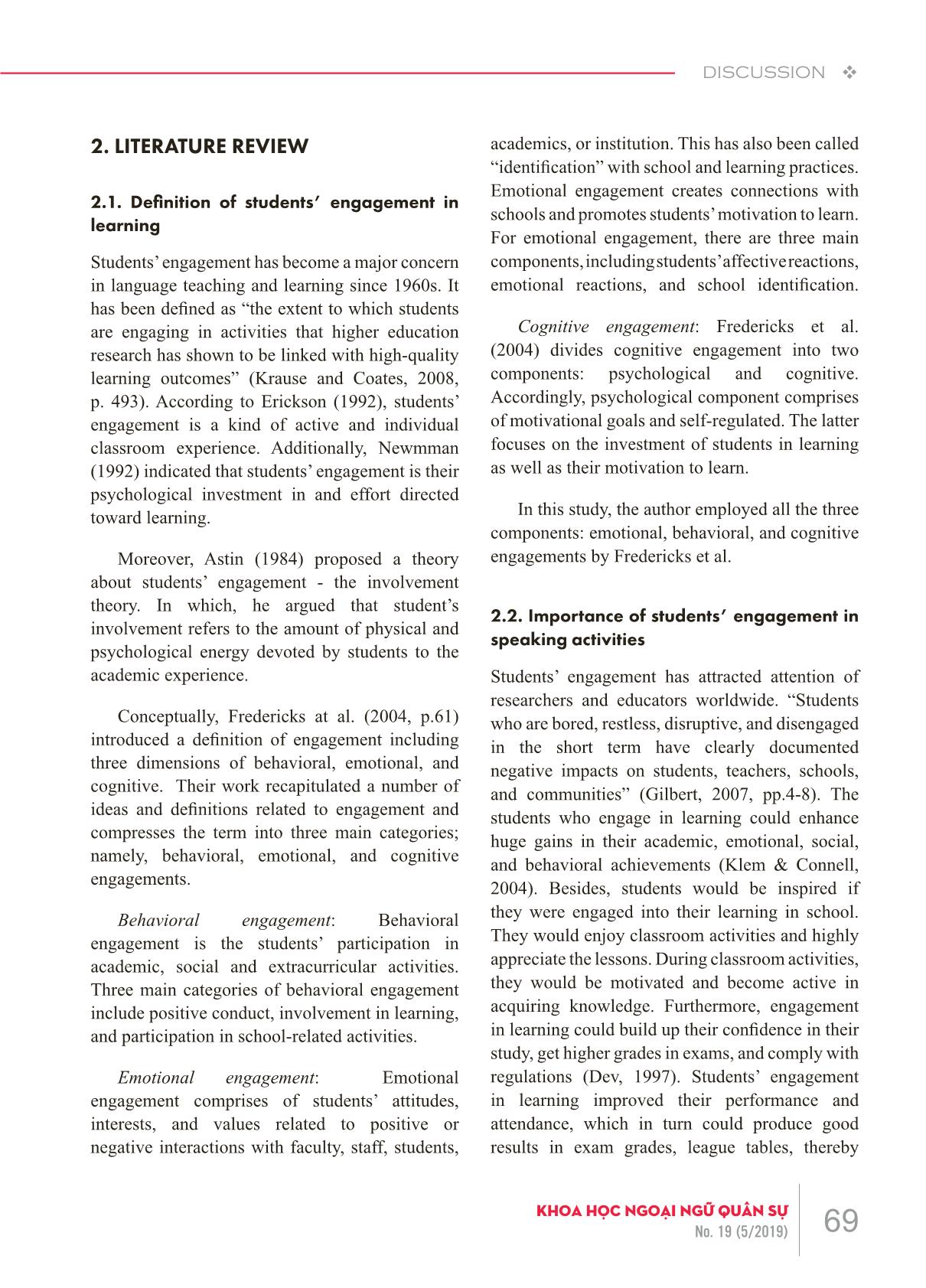
Trang 2
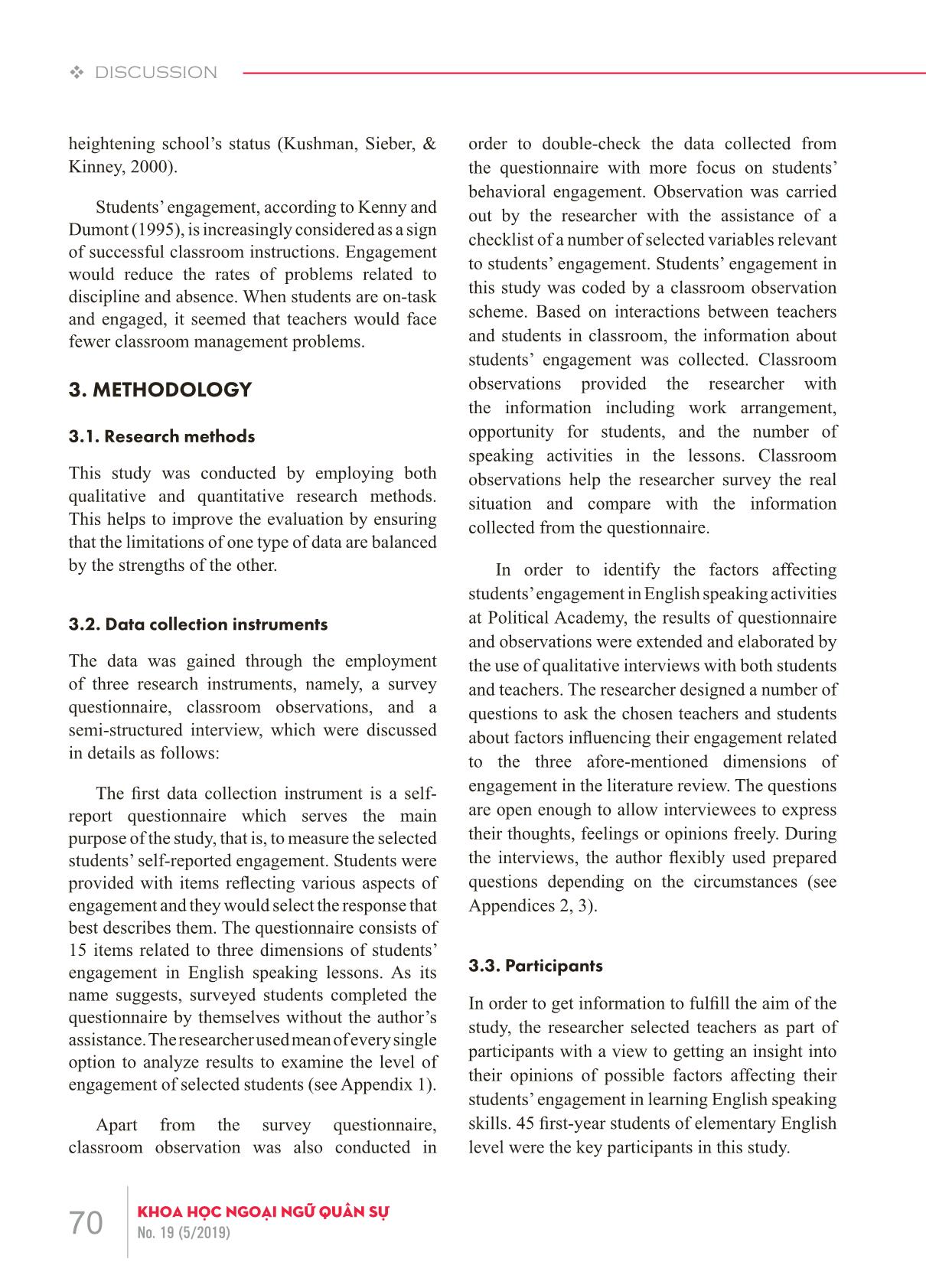
Trang 3
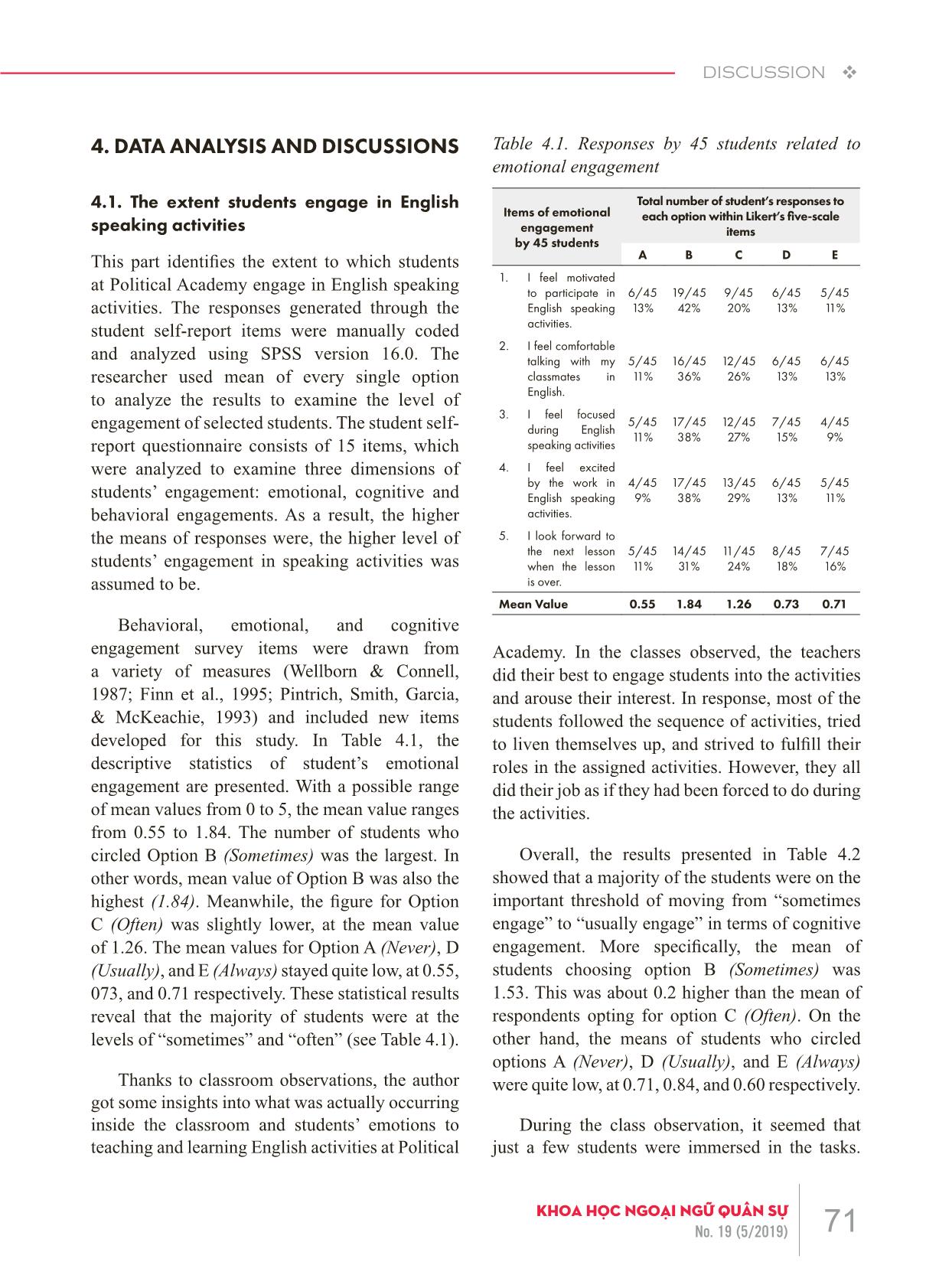
Trang 4
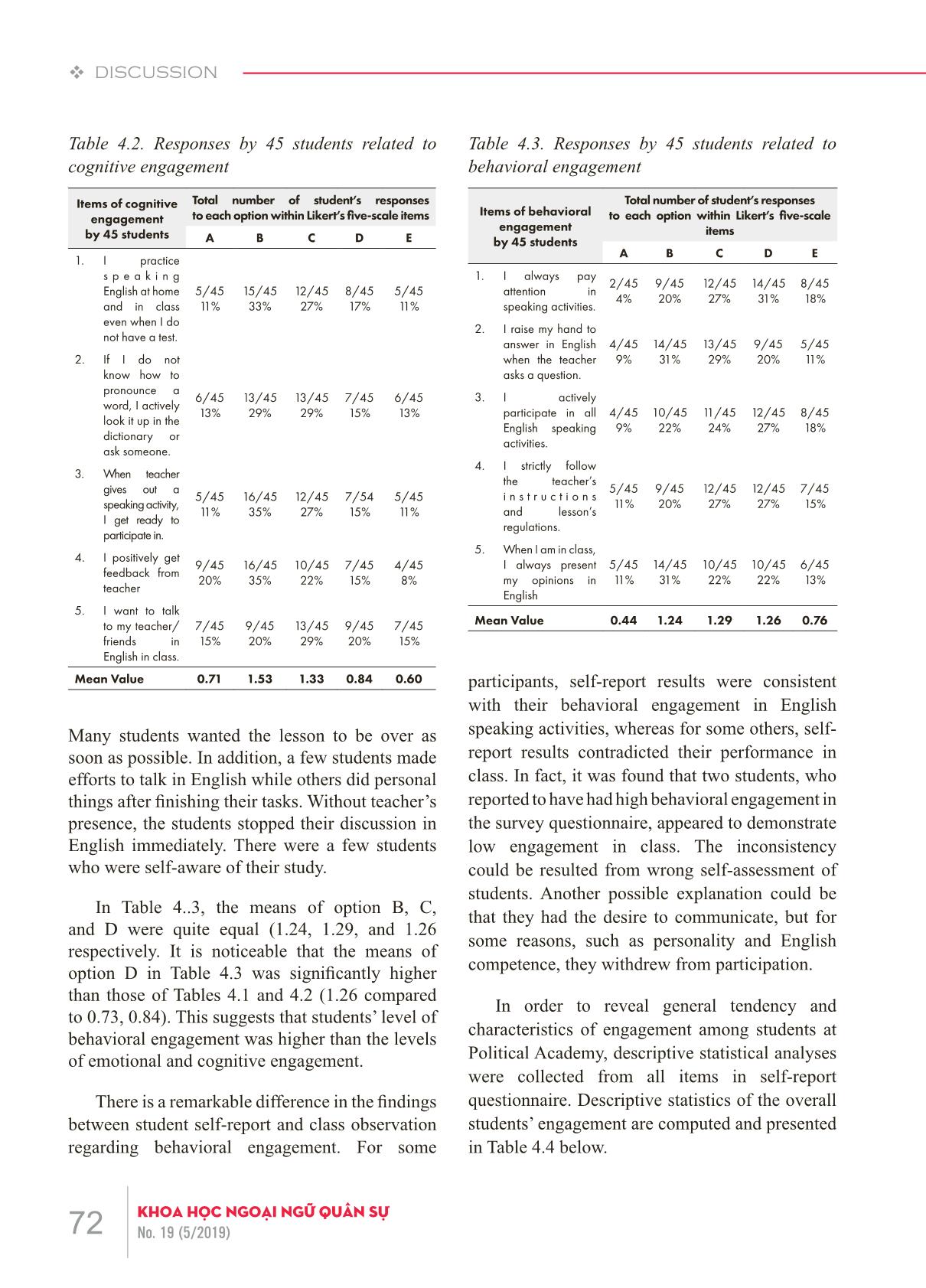
Trang 5
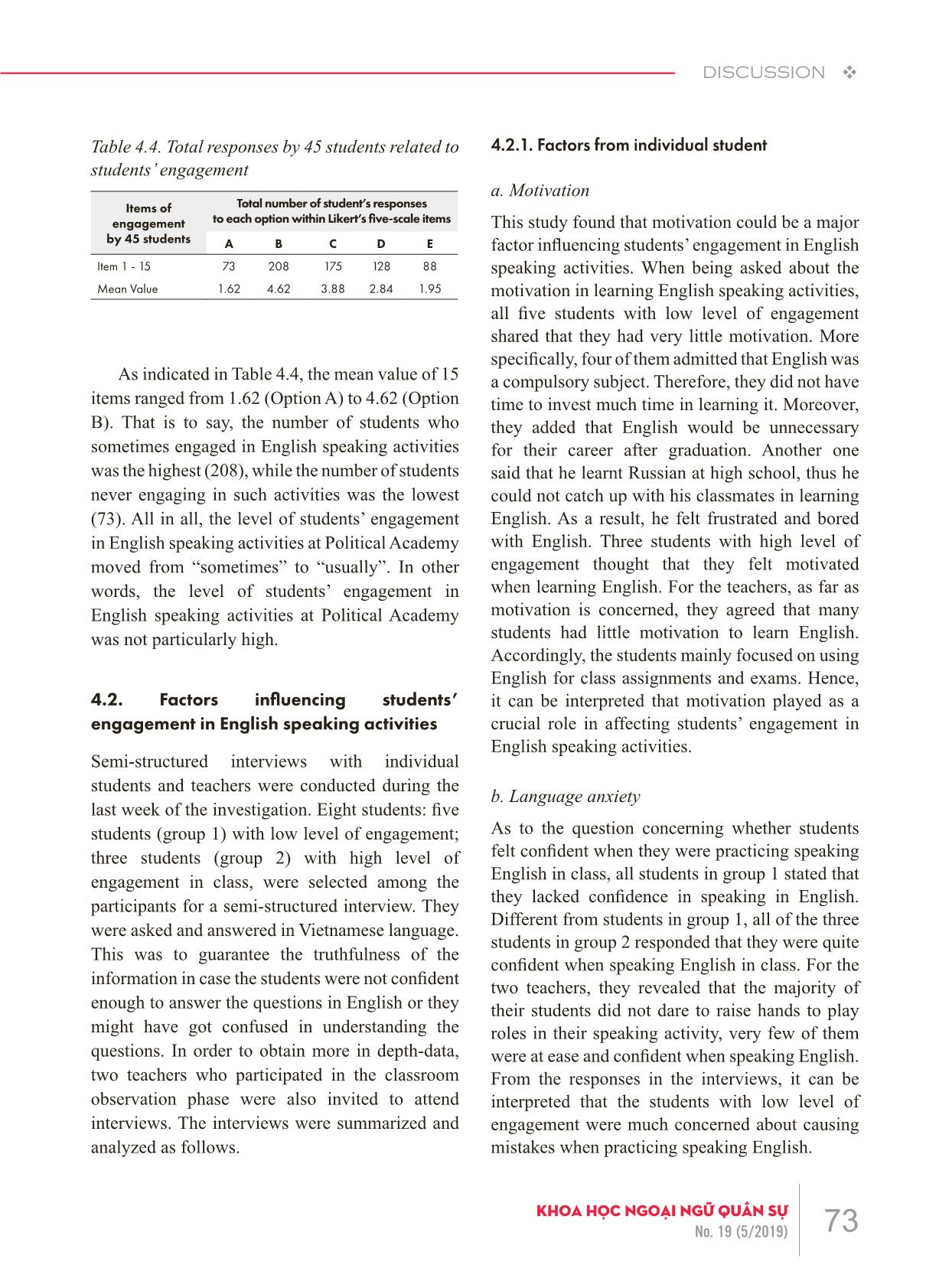
Trang 6
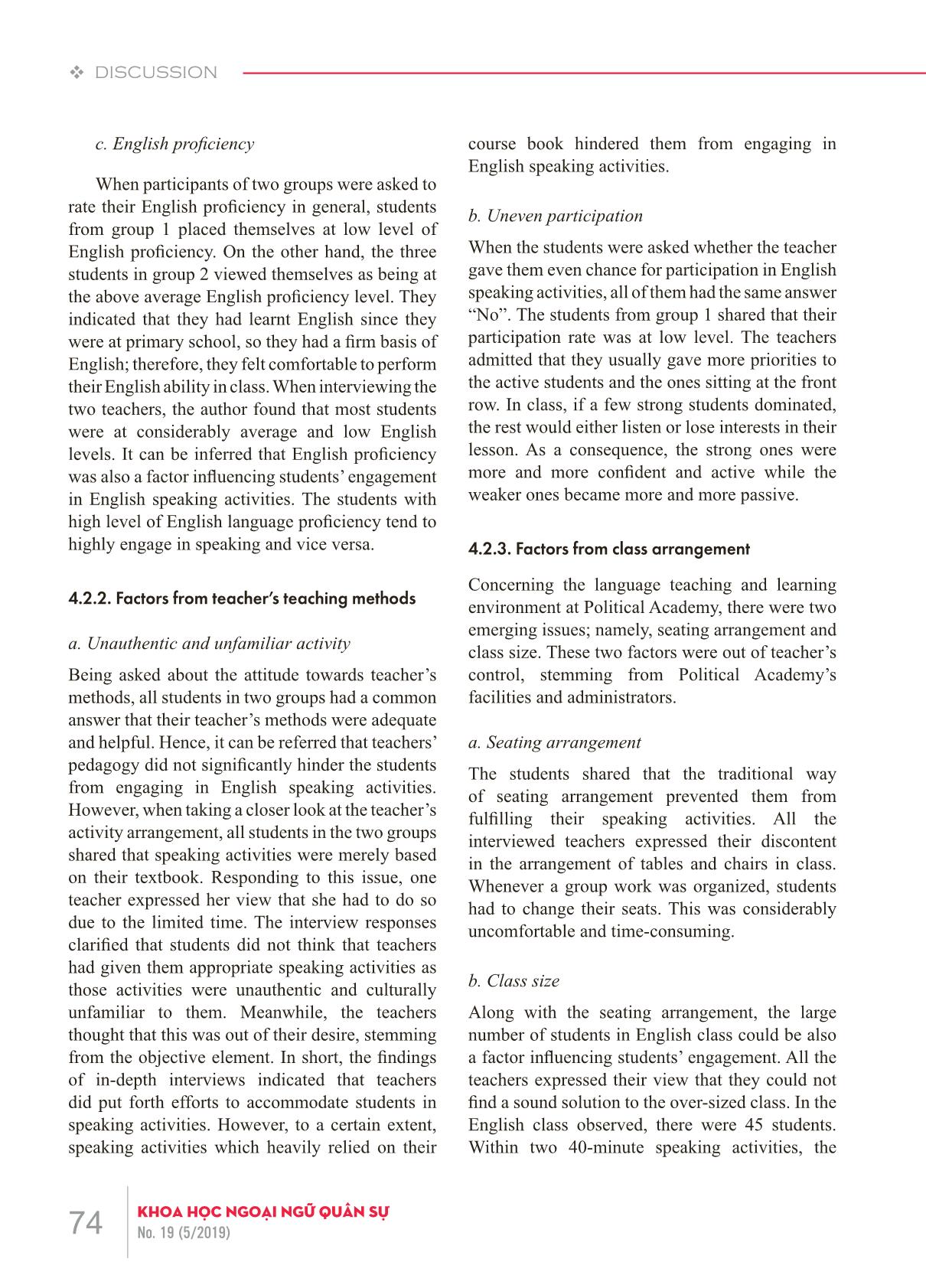
Trang 7
Bạn đang xem tài liệu "An investigation into students’ engagement in English speaking activities at political academy", để tải tài liệu gốc về máy hãy click vào nút Download ở trên
Tóm tắt nội dung tài liệu: An investigation into students’ engagement in English speaking activities at political academy
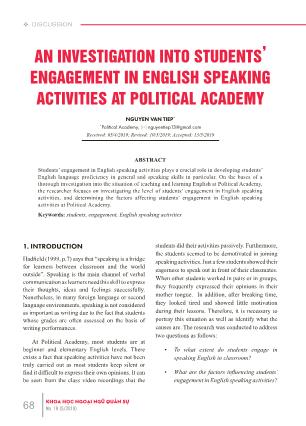
items, which were analyzed to examine three dimensions of students’ engagement: emotional, cognitive and behavioral engagements. As a result, the higher the means of responses were, the higher level of students’ engagement in speaking activities was assumed to be. Behavioral, emotional, and cognitive engagement survey items were drawn from a variety of measures (Wellborn & Connell, 1987; Finn et al., 1995; Pintrich, Smith, Garcia, & McKeachie, 1993) and included new items developed for this study. In Table 4.1, the descriptive statistics of student’s emotional engagement are presented. With a possible range of mean values from 0 to 5, the mean value ranges from 0.55 to 1.84. The number of students who circled Option B (Sometimes) was the largest. In other words, mean value of Option B was also the highest (1.84). Meanwhile, the figure for Option C (Often) was slightly lower, at the mean value of 1.26. The mean values for Option A (Never), D (Usually), and E (Always) stayed quite low, at 0.55, 073, and 0.71 respectively. These statistical results reveal that the majority of students were at the levels of “sometimes” and “often” (see Table 4.1). Thanks to classroom observations, the author got some insights into what was actually occurring inside the classroom and students’ emotions to teaching and learning English activities at Political Academy. In the classes observed, the teachers did their best to engage students into the activities and arouse their interest. In response, most of the students followed the sequence of activities, tried to liven themselves up, and strived to fulfill their roles in the assigned activities. However, they all did their job as if they had been forced to do during the activities. Overall, the results presented in Table 4.2 showed that a majority of the students were on the important threshold of moving from “sometimes engage” to “usually engage” in terms of cognitive engagement. More specifically, the mean of students choosing option B (Sometimes) was 1.53. This was about 0.2 higher than the mean of respondents opting for option C (Often). On the other hand, the means of students who circled options A (Never), D (Usually), and E (Always) were quite low, at 0.71, 0.84, and 0.60 respectively. During the class observation, it seemed that just a few students were immersed in the tasks. Table 4.1. Responses by 45 students related to emotional engagement Items of emotional engagement by 45 students Total number of student’s responses to each option within Likert’s five-scale items A B C D E 1. I feel motivated to participate in English speaking activities. 6/45 13% 19/45 42% 9/45 20% 6/45 13% 5/45 11% 2. I feel comfortable talking with my classmates in English. 5/45 11% 16/45 36% 12/45 26% 6/45 13% 6/45 13% 3. I feel focused during English speaking activities 5/45 11% 17/45 38% 12/45 27% 7/45 15% 4/45 9% 4. I feel excited by the work in English speaking activities. 4/45 9% 17/45 38% 13/45 29% 6/45 13% 5/45 11% 5. I look forward to the next lesson when the lesson is over. 5/45 11% 14/45 31% 11/45 24% 8/45 18% 7/45 16% Mean Value 0.55 1.84 1.26 0.73 0.71 72 KHOA HỌC NGOẠI NGỮ QUÂN SỰNo. 19 (5/2019) v DISCUSSION Many students wanted the lesson to be over as soon as possible. In addition, a few students made efforts to talk in English while others did personal things after finishing their tasks. Without teacher’s presence, the students stopped their discussion in English immediately. There were a few students who were self-aware of their study. In Table 4..3, the means of option B, C, and D were quite equal (1.24, 1.29, and 1.26 respectively. It is noticeable that the means of option D in Table 4.3 was significantly higher than those of Tables 4.1 and 4.2 (1.26 compared to 0.73, 0.84). This suggests that students’ level of behavioral engagement was higher than the levels of emotional and cognitive engagement. There is a remarkable difference in the findings between student self-report and class observation regarding behavioral engagement. For some participants, self-report results were consistent with their behavioral engagement in English speaking activities, whereas for some others, self- report results contradicted their performance in class. In fact, it was found that two students, who reported to have had high behavioral engagement in the survey questionnaire, appeared to demonstrate low engagement in class. The inconsistency could be resulted from wrong self-assessment of students. Another possible explanation could be that they had the desire to communicate, but for some reasons, such as personality and English competence, they withdrew from participation. In order to reveal general tendency and characteristics of engagement among students at Political Academy, descriptive statistical analyses were collected from all items in self-report questionnaire. Descriptive statistics of the overall students’ engagement are computed and presented in Table 4.4 below. Table 4.2. Responses by 45 students related to cognitive engagement Items of cognitive engagement by 45 students Total number of student’s responses to each option within Likert’s five-scale items A B C D E 1. I practice s p e a k i n g English at home and in class even when I do not have a test. 5/45 11% 15/45 33% 12/45 27% 8/45 17% 5/45 11% 2. If I do not know how to pronounce a word, I actively look it up in the dictionary or ask someone. 6/45 13% 13/45 29% 13/45 29% 7/45 15% 6/45 13% 3. When teacher gives out a speaking activity, I get ready to participate in. 5/45 11% 16/45 35% 12/45 27% 7/54 15% 5/45 11% 4. I positively get feedback from teacher 9/45 20% 16/45 35% 10/45 22% 7/45 15% 4/45 8% 5. I want to talk to my teacher/ friends in English in class. 7/45 15% 9/45 20% 13/45 29% 9/45 20% 7/45 15% Mean Value 0.71 1.53 1.33 0.84 0.60 Table 4.3. Responses by 45 students related to behavioral engagement Items of behavioral engagement by 45 students Total number of student’s responses to each option within Likert’s five-scale items A B C D E 1. I always pay attention in speaking activities. 2/45 4% 9/45 20% 12/45 27% 14/45 31% 8/45 18% 2. I raise my hand to answer in English when the teacher asks a question. 4/45 9% 14/45 31% 13/45 29% 9/45 20% 5/45 11% 3. I actively participate in all English speaking activities. 4/45 9% 10/45 22% 11/45 24% 12/45 27% 8/45 18% 4. I strictly follow the teacher’s i n s t r u c t i o n s and lesson’s regulations. 5/45 11% 9/45 20% 12/45 27% 12/45 27% 7/45 15% 5. When I am in class, I always present my opinions in English 5/45 11% 14/45 31% 10/45 22% 10/45 22% 6/45 13% Mean Value 0.44 1.24 1.29 1.26 0.76 73KHOA HỌC NGOẠI NGỮ QUÂN SỰNo. 19 (5/2019) DISCUSSION v As indicated in Table 4.4, the mean value of 15 items ranged from 1.62 (Option A) to 4.62 (Option B). That is to say, the number of students who sometimes engaged in English speaking activities was the highest (208), while the number of students never engaging in such activities was the lowest (73). All in all, the level of students’ engagement in English speaking activities at Political Academy moved from “sometimes” to “usually”. In other words, the level of students’ engagement in English speaking activities at Political Academy was not particularly high. 4.2. Factors influencing students’ engagement in English speaking activities Semi-structured interviews with individual students and teachers were conducted during the last week of the investigation. Eight students: five students (group 1) with low level of engagement; three students (group 2) with high level of engagement in class, were selected among the participants for a semi-structured interview. They were asked and answered in Vietnamese language. This was to guarantee the truthfulness of the information in case the students were not confident enough to answer the questions in English or they might have got confused in understanding the questions. In order to obtain more in depth-data, two teachers who participated in the classroom observation phase were also invited to attend interviews. The interviews were summarized and analyzed as follows. 4.2.1. Factors from individual student a. Motivation This study found that motivation could be a major factor influencing students’ engagement in English speaking activities. When being asked about the motivation in learning English speaking activities, all five students with low level of engagement shared that they had very little motivation. More specifically, four of them admitted that English was a compulsory subject. Therefore, they did not have time to invest much time in learning it. Moreover, they added that English would be unnecessary for their career after graduation. Another one said that he learnt Russian at high school, thus he could not catch up with his classmates in learning English. As a result, he felt frustrated and bored with English. Three students with high level of engagement thought that they felt motivated when learning English. For the teachers, as far as motivation is concerned, they agreed that many students had little motivation to learn English. Accordingly, the students mainly focused on using English for class assignments and exams. Hence, it can be interpreted that motivation played as a crucial role in affecting students’ engagement in English speaking activities. b. Language anxiety As to the question concerning whether students felt confident when they were practicing speaking English in class, all students in group 1 stated that they lacked confidence in speaking in English. Different from students in group 1, all of the three students in group 2 responded that they were quite confident when speaking English in class. For the two teachers, they revealed that the majority of their students did not dare to raise hands to play roles in their speaking activity, very few of them were at ease and confident when speaking English. From the responses in the interviews, it can be interpreted that the students with low level of engagement were much concerned about causing mistakes when practicing speaking English. Table 4.4. Total responses by 45 students related to students’ engagement Items of engagement by 45 students Total number of student’s responses to each option within Likert’s five-scale items A B C D E Item 1 - 15 73 208 175 128 88 Mean Value 1.62 4.62 3.88 2.84 1.95 74 KHOA HỌC NGOẠI NGỮ QUÂN SỰNo. 19 (5/2019) v DISCUSSION c. English proficiency When participants of two groups were asked to rate their English proficiency in general, students from group 1 placed themselves at low level of English proficiency. On the other hand, the three students in group 2 viewed themselves as being at the above average English proficiency level. They indicated that they had learnt English since they were at primary school, so they had a firm basis of English; therefore, they felt comfortable to perform their English ability in class. When interviewing the two teachers, the author found that most students were at considerably average and low English levels. It can be inferred that English proficiency was also a factor influencing students’ engagement in English speaking activities. The students with high level of English language proficiency tend to highly engage in speaking and vice versa. 4.2.2. Factors from teacher’s teaching methods a. Unauthentic and unfamiliar activity Being asked about the attitude towards teacher’s methods, all students in two groups had a common answer that their teacher’s methods were adequate and helpful. Hence, it can be referred that teachers’ pedagogy did not significantly hinder the students from engaging in English speaking activities. However, when taking a closer look at the teacher’s activity arrangement, all students in the two groups shared that speaking activities were merely based on their textbook. Responding to this issue, one teacher expressed her view that she had to do so due to the limited time. The interview responses clarified that students did not think that teachers had given them appropriate speaking activities as those activities were unauthentic and culturally unfamiliar to them. Meanwhile, the teachers thought that this was out of their desire, stemming from the objective element. In short, the findings of in-depth interviews indicated that teachers did put forth efforts to accommodate students in speaking activities. However, to a certain extent, speaking activities which heavily relied on their course book hindered them from engaging in English speaking activities. b. Uneven participation When the students were asked whether the teacher gave them even chance for participation in English speaking activities, all of them had the same answer “No”. The students from group 1 shared that their participation rate was at low level. The teachers admitted that they usually gave more priorities to the active students and the ones sitting at the front row. In class, if a few strong students dominated, the rest would either listen or lose interests in their lesson. As a consequence, the strong ones were more and more confident and active while the weaker ones became more and more passive. 4.2.3. Factors from class arrangement Concerning the language teaching and learning environment at Political Academy, there were two emerging issues; namely, seating arrangement and class size. These two factors were out of teacher’s control, stemming from Political Academy’s facilities and administrators. a. Seating arrangement The students shared that the traditional way of seating arrangement prevented them from fulfilling their speaking activities. All the interviewed teachers expressed their discontent in the arrangement of tables and chairs in class. Whenever a group work was organized, students had to change their seats. This was considerably uncomfortable and time-consuming. b. Class size Along with the seating arrangement, the large number of students in English class could be also a factor influencing students’ engagement. All the teachers expressed their view that they could not find a sound solution to the over-sized class. In the English class observed, there were 45 students. Within two 40-minute speaking activities, the
File đính kèm:
 an_investigation_into_students_engagement_in_english_speakin.pdf
an_investigation_into_students_engagement_in_english_speakin.pdf

